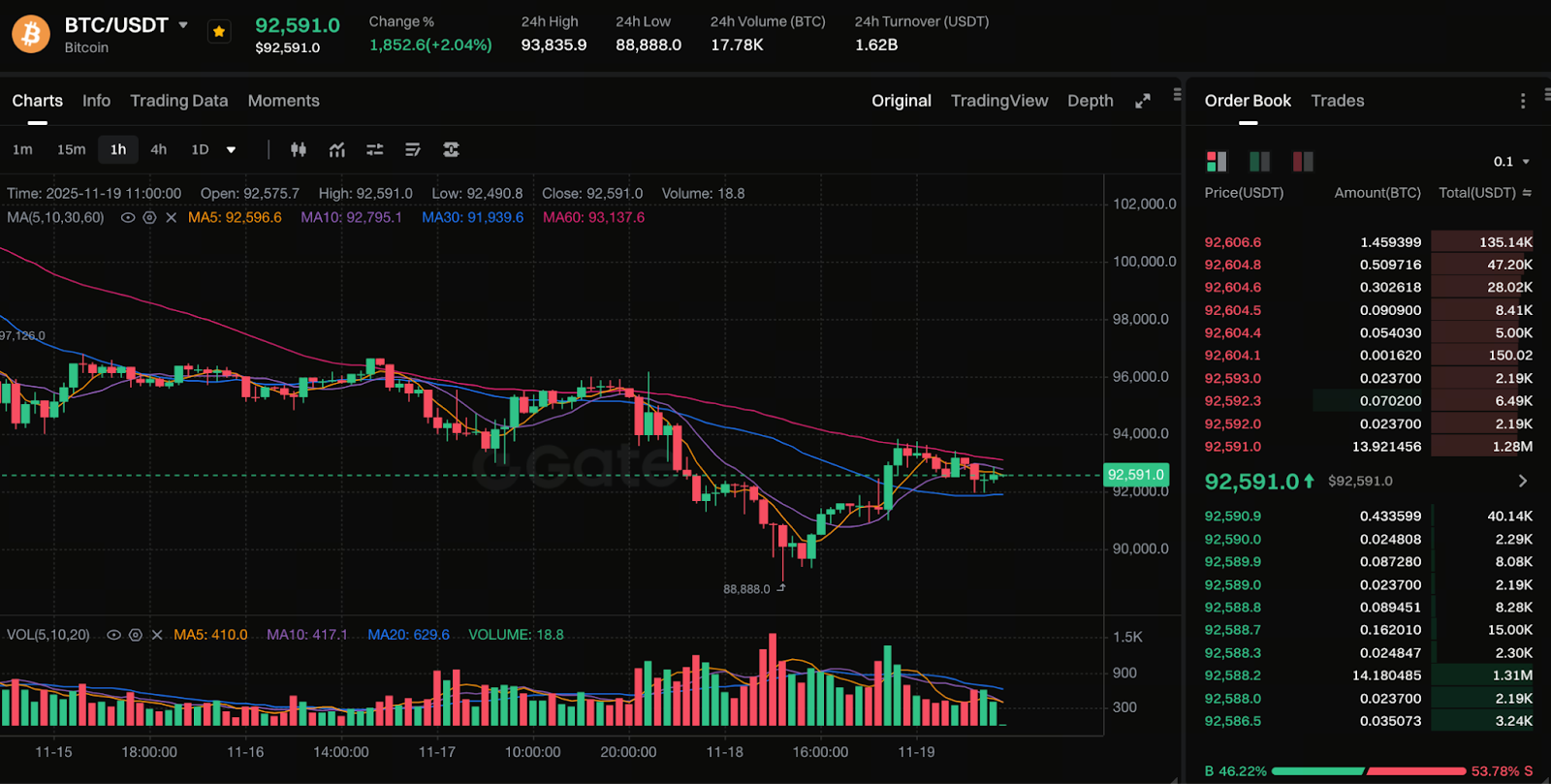Bitcoin Breaks Below $90,000 – A Sharp Correction Erases 2025 Gains
Market Overview: Why Did Bitcoin Fall Below $90,000?

Chart: https://www.gate.com/trade/BTC_USDT
In mid-November 2025, Bitcoin’s price briefly dropped to around $89,000, breaking below the $90,000 threshold for the first time in seven months. This decline wiped out all year-to-date gains and further dampened market sentiment. Bitcoin had previously surged above $126,000 in October, but the swift correction wiped out those advances just as quickly.
Scale of Decline Compared to History
Bitcoin fell from a peak above $126,000 to roughly $89,000—a drop of about 30%. This reversal wiped out all year-to-date gains and caught many investors off guard. Compared to past Bitcoin corrections, this move was both faster and sharper. While similar pullbacks have happened before, today’s market sentiment and macroeconomic environment remain different from previous cycles.
Key Drivers Behind the Decline
- Macroeconomic shifts and changing interest rate expectations: Diminished anticipation of Federal Reserve rate cuts reduced the attractiveness of risk assets.
- Reversal of capital flows: Major holders (“whales”) began to exit, with outflows observed in both ETFs and spot funds.
- Rising industry pressures: Higher Bitcoin mining costs and mounting energy concerns prompted some miners to scale back or liquidate assets.
- Growing risk aversion in the market: Investor confidence in volatile assets waned, and simultaneous corrections in the technology and AI sectors intensified the impact.
Technical and Liquidity Supports and Risk Factors
Technically, Bitcoin previously held several support levels between $90,000 and $95,000. Breaking below this range disrupted the bullish structure, signaling short-term market weakness. Key technical indicators—including the 1-year moving average and major trend lines—were breached simultaneously, putting the market into a higher-risk adjustment phase. If Bitcoin cannot quickly reclaim the $90,000 level, selling pressure may continue to build, with a near-term risk of further tests down to $85,000 or even $75,000.
Liquidity has also tightened. Recent net outflows from spot ETFs and on-exchange funds have weakened buying momentum compared to previous months. In addition, large holders and miners have taken profits at elevated prices, transferring holdings to short-term traders and increasing volatility. Institutional sentiment has cooled as risk tolerance decreases, accelerating the correction.
Still, some analysts argue that despite rapid losses this year, Bitcoin’s long-term trajectory remains intact, with medium- and long-term support zones still capable of holding. If macro liquidity improves or new capital enters, this correction may ultimately represent a healthy adjustment within a larger uptrend, rather than a reversal of the overall direction.
Investor Guidance: What Should Newcomers Prioritize?
- Stop-loss and position management: With volatility dramatically higher, risk control should be a top priority for new investors. Avoid going all-in or chasing rebounds impulsively. Set appropriate stop-loss limits and keep positions flexible to preserve room for action during extreme swings.
- Staggered entry and patient allocation: If you’re confident in Bitcoin’s medium- or long-term prospects, entering the market in phases is more prudent than lump-sum buying. Use price swings during corrections to diversify your entry costs, reducing the risk of buying at local highs and helping you avoid making emotional decisions.
- Track macro and capital flow signals: Bitcoin’s price often moves with macro policy and liquidity trends. Keep an eye on Federal Reserve rate expectations, dollar liquidity, miner production costs, and institutional position changes—these are key metrics for trend analysis. Newcomers should learn to follow these signals, not just short-term price action.
- Beware emotional reactions and cognitive biases: Sharp declines often trigger profit-taking anxiety or panic selling among new investors, while early rebounds can spark FOMO-driven buying. Stay calm, stick to your established strategy, and avoid impulsive trades driven by emotion to best protect your capital in turbulent markets.
Conclusion: Is the Correction a Bear Market or a New Opportunity?
Bitcoin’s break below $90,000 has clearly heightened market tension, but it doesn’t necessarily signal the start of a bear market. This swift, steep decline looks more like the result of tight liquidity and concentrated sentiment. For newcomers, such corrections often mark a classic phase when risks become apparent and opportunities arise. The key is maintaining sensible positions, clear strategies, and patience. The market’s direction will depend on ongoing changes in macro conditions, capital flows, and sentiment.
Related Articles

Pi Coin Transaction Guide: How to Transfer to Gate.io

Flare Crypto Explained: What Is Flare Network and Why It Matters in 2025

How to Use a Crypto Whale Tracker: Top Tool Recommendation for 2025 to Follow Whale Moves

2025 BTC Price Prediction: BTC Trend Forecast Based on Technical and Macroeconomic Data

What is N2: An AI-Driven Layer 2 Solution
